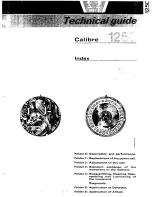
F ) M e c a n i s m o d e c a m b i o d e f e c h a
i n s t a n t á n e a
En un reloj provisto de un mecanismo de calen-
dario corriente, el cambio de fecha se efectúa
aproximadamente entre las 22 y 24 horas. La
fecha se va desplazando progresivamente, lo
que da lugar a una lectura desagradable de la
misma. Este inconveniente queda suprimido con
nuestro sistema de cambio instantáneo. Está
concebido de forma que la fecha cambia instan-
táneamente a media noche.
Para ello una báscula (2632) cooperando con el
dedo (2552), desplazado este por medio del
rodaje, arma progresivamente el muelle (2633).
En el momento previsto, el dedo libera la báscula
y en una fracción de segundo el calendario (2557)
recibe la impulsión necesaria para que el cam-
bio de fecha se efectué. La posición del calen-
dario es asegurada continuamente por el trin-
quete (2576).
G ) M e c a n i s m o a u t o m á t i c o
El mecanismo automático de carga comprende:
- Un rotor formado por un segmento de carburo
de tungsteno y una parte central elástica que
sirve de amortiguador en caso de grandes
choques. El rodamiento de bolas le asegura
una suspensión muy sensible que le permite
girar con el mínimo movimiento.
- Un móvil de reducción
- Una rueda-trinquete asegurando la carga en
cualquiera de la dos direcciones que gire el
rotor.
- Una rueda de transmisión inversora.
- Un móvil engranando con la rueda de corona.
F ) I n s t a n t a n e o u s j u m p c a l e n d a r
m e c h a n i s m
In a watch equipped with a traditional calendar
mechanism, the change of date generally takes
place from 10 p.m, around midnight. The date
indicator moves progressively in the calendar
window and creates an unpleasant inaccuracy
of reading. This inconvenience is eliminated by
our instantaneous jump calendar device. There-
fore the date will change instantaneously at
midnight.
A reléase lever of the date indicator (2632) co-
operating with the calendar finger (2552) driven
by the train, winds progressively the reléase lever
spring of the date indicator (2633). At midnight,
the reléase lever (2632) is freed by the finger.
This latter gets then the necessary impulse to
move the date indicator (2557) the position of
which is ensured by the date jumper (2576).
G ) A u t o m a t i c w i n d i n g m e c h a n i s m
The automatic winding mechanism consists of:
- An oscillating weight (rotor) constituted by
an outside segment made of tungsten car-
bide, which has a high density, and a central
elastic part functioning as an absorber in case
of a strong shock. A ball-bearing permits the
weight to rotate easily and freely with the
slightest motion of the wrist.
- A reduction gear.
- A pawl winding wheel which ensures the
winding in both directions of rotation of the
oscillating weight.
- A reverser connecting wheel,
- A driving g e a r f o r crown wheel.














































